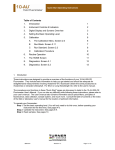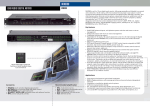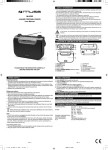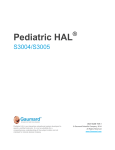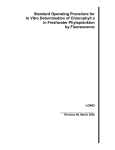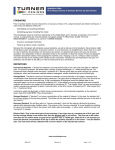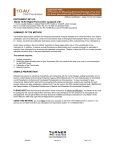Download Using the Turner Designs Model 10AU Fluorometer to Perform Flow
Transcript
Application Note: Using the Turner Designs Model 10-AU
Fluorometer to Perform Flow Measurements in Sanitary
Sewers by Dye Dilution
Instrument set-up: Model 10-AU Digital Fluorometer equipped with the 13 mm x 100 mm cuvette holder; and a 10056/10-056R (546 nm) Excitation Filter, a 10-052/10-052R (>570 nm) Emission Filter, 10-053/10-053R (>535 nm)
Reference Filter, and 10-046 Clear Quartz Lamp, installed.
CONTENTS
SUMMARY OF THE METHOD
SETTING THE BASIC OPERATING LEVEL
OBTAINING STANDARDS AND BLANKS
MEASUREMENTS
FLOW RATE CALCULATION
1
2
3
3
5
SUMMARY OF THE METHOD
The procedure requires:
Flow in sanitary sewers may be measured to an
accuracy of ± 1% using fluorescent dye dilution
techniques.
This procedural guide includes step-by-step
instructions for using the Turner Designs Model 10AU Digital Fluorometer for measuring flow in sanitary
sewers.
Since there is no need to crawl a manhole, the
procedure can be done by one person. Samples may
be measured on the spot, or if preferred, may be
taken to the office or a lab and measured at your
convenience.
1.
Setting the basic operating level of your
fluorometer (this only needs to be done once,
prior to running samples for the FIRST time).
2.
Obtaining Standards & Blank
3.
Measurements:
a. Recovery ratio test
b. Reading samples
4.
Flow rate calculation.
Detailed discussion of principles, equipment, sample
collection, preparation of standards, and flow rate
calculations can be found in the Turner Designs
monograph, "Fluorometric Facts: Flow Measurements
in Sanitary Sewers by Dye Dilution" (referred to
hereafter as "Sanitary Sewers").
www.turnerdesigns.com
998-5001
Revision A
Page 1 of 6
Application Note: Using the Turner Designs Model 10-AU
Fluorometer to Perform Flow Measurements in Sanitary
Sewers by Dye Dilution
SETTING THE BASIC OPERATING LEVEL
The basic operating level of your fluorometer is set on
screen 3.2 using the Sensitivity Adjustment Knob.
Procedure:
Fluorescence readout: XXXX.XXX
PM signal output: XXXX.XXX
Cal std val: XXX.XX Blank: XX.XXX
FS: XX% of XXXX.XXX (PPB) at HIGH
Span level%: 48
<ENT> to next screen
Take care not to spill any liquids inside the
fluorometer's sample chamber. If you do have a
spill, turn off the fluorometer immediately and
consult the Sample System appendix of your
user's manual. Wipe up splashes on the
instrument's exterior promptly.
1.
Turn on the fluorometer and allow to warm up for
10 minutes.
2.
On the keypad, access screen 2.0, Calibration.
Press <6> once and then <9> five times to reset
calibration defaults.
3.
From screen 2.0, press <4>, then <2> to access
screen 2.42. Set the concentration range to
HIGH.
4.
Access screen 3.2, Diagnostic.
5.
Loosen (do not remove) the Sensitivity Knob
Lock (hex screw to the left of the keypad; see
Figure 1 in the user's manual) with the 5/32"
Allen wrench (behind, lower right of the keypad).
6.
Fill a clean 13 mm test tube with the 100 ppb
dilution. Dry the outside of the tube with a lab
wipe and insert it in the opening to the sample
compartment. Replace the light cap.
7.
On screen 3.2, look at the third line from the
bottom: FS: XX% of XXX (ppb) at HIGH. Turn
the Sensitivity Knob (large screw to the lower
right of the keypad) slowly, pausing between
adjustments for the reading to stabilize, until the
FS % reads approximately:
#3.2
Diagnostic Screen #3.2
Your user's manual contains detailed instructions for
setting the basic operating level (Appendix 5B of the
Model 10-AU-000 Laboratory Fluorometer User's
Manual and Appendix 6B of the Model 10-AU-005
Field Fluorometer User's Manual).
Once the basic operating level (sensitivity) is set, you
should not have to adjust it unless you want to
drastically increase or decrease sensitivity.
Through experience, we have found the following
operating level to be appropriate for flow
measurements in sanitary sewers.
The maximum concentration you will wish to read is
500 ppb (0.5 ppm). This is the upper limit of the linear
range for rhodamine WT. While this limit is actually
dependent on the path length of the cuvette, this is a
safe figure for even the largest cuvette.
Prepare a dilution of 100 ppb of Rhodamine WT. This
standard does not have to be very accurately
prepared. It will not be used to standardize the
instrument during calibration. Its purpose is to adjust
the instrument to optimum operating level -- which is
quite broad. To prepare the 100 ppb dilution:
1.
Dilute 1 ml of the pure tracer (20% aqueous
solution) to 1000 ml.
2.
Then 1 ml of this initial dilution to 100 ml.
3.
Finally, 1 ml of the second dilution to 100 ml.
FS: 20% of 900.000 at HIGH
Turning the Sensitivity Knob clockwise increases
the FS %; turning it counter-clockwise decreases
FS %.
8.
When an FS % of about 20 is reached, use the
Allen wrench to tighten the Sensitivity Knob
Lock. (IMPORTANT!)
9.
Remove the 100 ppb dilution from the
fluorometer and set aside.
10. Proceed to the next section.
www.turnerdesigns.com
998-5001
Revision A
Page 2 of 6
Application Note: Using the Turner Designs Model 10-AU
Fluorometer to Perform Flow Measurements in Sanitary
Sewers by Dye Dilution
OBTAINING STANDARDS AND BLANK
a known concentration of the Sewage Standard, only
a known dilution.
Standards are required to calibrate the fluorometer
precisely in terms of the dye that you injected.
Readings will be taken from the HOME screen or
Screen 3.2 (see explanation, below):
For detailed instructions for sample collection and
preparation, preparation of your Sewage Blank and
preparation of your Sewage and Recovery Standards
consult the "Preparation of Standards" section of the
"Sanitary Sewers" monograph.
CONC: MED (MAN)
Time Const: 2 (SEC)
Definitions:
Recovery Standard: A dilution of the dye--exact
same dilution as the sewage standard--being injected
made with deionized water (distilled water). The
purpose of the "recovery standard" is to see whether
the reading of a given concentration of dye is the
same in clean water and sewage -- in other words,
whether the dye is all "recovered" in sewage.
Sewage Standard: A known dilution of the dye being
injected mixed with sewage collected just prior to the
start of dye injection.
Sewage Blank: Sewage collected just prior to the
start of dye injection. This will represent the amount
of fluorescent materials occurring naturally in the
system, expressed as a concentration of the
fluorescent material being measured.
To perform your recovery ratio test and run your
samples, you will need:
1.
One cuvette filled with a blank of distilled water.
2.
Two cuvettes filled with Recovery Standard.
3.
Two cuvettes filled with Sewage Standard.
4.
One cuvette filled with Sewage Blank.
______________________________________
0
499
999
<?> for help
If you prefer to see more digits than are shown on the
HOME screen (XXXX.XXX), you MAY record your
readings from the Diagnostic screen 3.2. The reading
from the top line of this screen is what is sent to the
HOME screen, rounded off to three digits. To avoid
inconsistency, record readings from the HOME
screen or screen 3.2, but not both.
The Model 10-AU has two features of special interest
for this method:
1.
The Discrete Sample Averaging capability,
where the instrument averages a reading over a
preset period, allowing you to read samples after
they have been in the instrument for the same
time. This minimizes errors due to temperature
changes and removes the guesswork from
reading the digital display. Defaults for this
feature on the Model 10-AU are 15 seconds predelay for the signal to stabilize, and an averaging
period of 10 seconds. (To change these periods,
access screen 1.63. See the appendix on
Operational Parameters, screen 1.63, of your
user's manual.) To use Discrete Sample
Averaging, after putting in a sample, from the
HOME screen, press <*> and the instrument will
countdown a delay period, average the reading,
and then display "DONE" in the upper right hand
corner of the screen. The averaged reading will
be displayed for 10 seconds so you can write it
down.
2.
Auto-ranging. In AUTO, the fluorometer will
automatically select the range with the best
resolution for the sample being read. You will,
however, have to wait for the instrument to
change ranges, as well as for the reading to
Your various samples, each in its own cuvette.
MEASUREMENTS
We are looking for the ratio of the Sewage Standard
to samples (i.e., the readings of samples relative to
the Sewage Standard). Thus, we will set the Model
10-AU to subtract the Sewage Blank, but will not use
4:42:05 PM 1/25/93
HOME Screen
If you are studying Blank variability, you may
have a number of cuvettes filled with Sewage
Blank. Refer to the "Dye Injection - Dye
Concentration" section of the "Sanitary Sewers"
monograph.
5.
XXX (PPB)
www.turnerdesigns.com
998-5001
Revision A
Page 3 of 6
Application Note: Using the Turner Designs Model 10-AU
Fluorometer to Perform Flow Measurements in Sanitary
Sewers by Dye Dilution
stabilize. The instrument will change ranges
whenever the light cap is removed. (To set to
auto-ranging, access screen 2.43 and set to
AUTO.)
Use UP or DOWN arrow to set Blank %
to less than 200%!
Blank%:
For these reasons, we recommend that you read
samples in the manual mode (MAN, set on
screen 2.43).
The best resolution is obtained by reading
samples on the lowest range possible. In most
however, even if you read all of your samples on
the HIGH range you will obtain adequate results,
as the 10-AU has been designed with good
range-to-range correlation.
TC: 8 (SEC) Range: MED
Press <0> after reading is stable!
Screen 2.11
If you wish to abort the blank run and revert
to the former calibration settings, press
<ESC> before pressing <0>. This will retain
the current settings for Span and blank.
Recovery Ratio
Before proceeding, if you have not already done
so before using the instrument for the FIRST time,
set the basic operating level of your fluorometer
as described in the previous section.
Fill a clean 13 mm test tube with a blank of
distilled water. Put the blank into in the sample
chamber and replace the light cap. After the
Blank % reading is stable ("TC" on screen 2.11
cycles from 1 to 8 sec) and assuming the Blank
% is less than 200%, press <0>. When
"FINISHED" appears, press <HOME>.
Recovery Ratio tests are important in predicting the
precision of your flow measurements and guiding you
in improving this precision.
1.
Turn on the fluorometer and allow it to warm up
for 10 minutes.
2.
From the Main Menu, press <2> to access
screen 2.0, Calibration.
3.
Set the concentration range control to MAN.
From screen 2.0, press <4> to bring up screen
2.4, then <3> to bring up screen 2.43 (set conc.
range control), and press <ENT> to toggle.
4.
Set the concentration range to MED. From
screen 2.4, press <2> to bring up screen 2.42
(change concentration range), and press <ENT>
to toggle. Return to screen 2.0.
5.
To run the Distilled Water Blank, press <1> to
access screen 2.1. Make sure #2 on screen 2.1
reads YES. Then, from screen 2.1, press <1> to
call up screen 2.11.
Span: 48%
#2.11
For this procedure, do not adjust the Span%
by pressing the UP or DOWN arrows. Span%
should remain at the default of 48.
Remove the Distilled Water Blank.
6.
Set the concentration range to HIGH. From
screen 2.4, press <2> to bring up screen 2.42
(change concentration range), and press <ENT>
to toggle. Go to the HOME screen (or screen
3.2).
7.
Insert a cuvette containing your Recovery
Standard. Record the reading from the HOME
screen (or screen 3.2).
This reading is not an actual concentration.
Since you have not calibrated with a standard of
known concentration, what you are reading is
relative concentration. You only need to know
relative concentration for this method.
8.
Insert a cuvette containing your Sewage
Standard. Record the reading from the HOME
screen (or screen 3.2).
9.
Insert the cuvette containing your Sewage Blank.
Record the reading from the HOME screen (or
screen 3.2). For better resolution, read on the
MED range.
www.turnerdesigns.com
998-5001
Revision A
Page 4 of 6
Application Note: Using the Turner Designs Model 10-AU
Fluorometer to Perform Flow Measurements in Sanitary
Sewers by Dye Dilution
10. Subtract reading 9 from reading 8. This net
reading is the reading due to the dye present in
the sewage.
For better resolution, read your sample on the
lowest range in which you can obtain an on-scale
reading. In the MAN mode, access screen 2.42
to change ranges. (In AUTO, the instrument will
find the best range.)
11. Divide the net reading from step 10 by the
reading from step 7 to get the Recovery Ratio.
To see what the ratio means, refer to "Recovery
Ratio Test" in the "Sanitary Sewers" monograph.
If you see OVER on the LOW or MED range,
access screen 2.42 and change to a higher
range.
12. Proceed to the next section.
Reading Samples
Remember, we are looking for the ratio of the Sewage
Standard to samples (i.e., the readings of samples
relative to the standard). It is presumed that you have
just run the Recovery Ratio described above.
If any sample reads "OVER" on the HIGH range,
you must dilute the sample. Refer to the "High
Concentration Measurements" section of the
"Sanitary Sewers" monograph.
4.
When all samples have been read, and you are
finished for the day, turn off the fluorometer.
Continuing from the Recovery Ratio section:
1.
NOTE: If you are going to be reading samples
off-and-on over the course of a few days, leave
the fluorometer on; it won't hurt it.
Insert the cuvette containing your Sewage Blank.
(For better resolution, read on the MED range-access screen 2.42 to change ranges.) Record
the reading from the HOME screen (or screen
3.2).
FLOW RATE CALCULATION
The mathematical equation normally used to calculate
flow is:
If you prefer, you may run this as your actual
blank, in place of distilled water. However, it is
useful to know how large the Sewage Blank is. If
it is small compared to the standard and
samples, then you are more confident of the
relative accuracy of the test. If a small blank
varies by a few percent, it is negligible. If a large
one varies the same percentage, the error in the
answer will be proportionately larger.
1.
Q = q C/c
Where:
Q
q
C
c
Therefore, we recommend that you leave the
Distilled Water Blank set to zero. This way you
definitely have a record of the magnitude of the
Sewage Blank; repeats will always have positive
values; and you may average 3 or more cuvettes
of Sewage Blank for greater accuracy. You will
always work with the net reading: sample (or
standard) minus the Sewage Blank.
is the flow being measured
is the dye injection rate
is the concentration of the injected dye
is the concentration of dye measured
downstream of injection
Since fluorescence is normally proportional to
concentration, a more practical form of this equation
is:
2.
Q = q x Rst D/r
Where:
2.
Set to the HIGH range on screen 2.42. Insert the
cuvette containing your Sewage Standard into
the instrument. Record the reading from the
HOME screen (or screen 3.2).
Q
q
Rst
r
D
As with the Sewage Blank, you may want to read
and average 3 or more cuvettes containing the
Sewage Standard.
is the flow being measured
is the dye injection rate
is the reading obtained on your standard
is the reading obtained on your sample
is the dilution ratio, used to prepare the
standard
We will use equation 2.
3.
One by one, insert the cuvettes containing your
samples and record the readings from the HOME
screen (or screen 3.2).
www.turnerdesigns.com
998-5001
Revision A
Page 5 of 6
Application Note: Using the Turner Designs Model 10-AU
Fluorometer to Perform Flow Measurements in Sanitary
Sewers by Dye Dilution
Sample Readings (r). Sample readings are net
readings, IF sewage blank was set to zero. If the
distilled water blank was set to zero, then subtract the
sewage blank reading from all readings, including the
standard (Rst), to obtain the actual net reading.
Injection Rate (q). The Injection Rate is normally
determined by finding the time it takes to fill a
volumetric flask, See DYE INJECTION -- Calibrating
the Injector in the "Sanitary Sewers" monograph.
Since volumetric flasks are calibrated in milliliters and
elapsed time is most easily measured in seconds, we
must make a conversion.
Example:
We wish to calculate the flow in mgd.
q =
Rst =
r
=
D =
Q =
00.0000144 mgd (Injection Rate)
95.4 (Dye Reading)
24.8 (Dye Reading)
100,000 (Standard Dilution Ratio)
0.0000144 x 95.4 x 100,000/25.8 = 5.32
mgd, or more reasonably stated, 5.3 mgd.
Of course, if you are measuring several flows from
one injection, the obvious thing to do is calculate q
Rst D, as r is the only variable, from sample to
sample.
Two handy numbers are:
milliliters x .0002642 = U.S. gallons
milliliters x .00003532 = cubic feet
As an example, let's presume that when you tested
your dye injector, you found that it took 158 seconds
to fill a 100 ml volumetric flask.
This means that the flow rate was 100 divided by 158,
or 0.631 milliliters per second, or 37.85 milliliters per
minute.
If you wish your final answer to be in mgd, then the
rate of dye introduced must also be in mgd.
To convert milliliters per minute to gallons per minute,
multiply 37.85 by .0002642, yielding .01 gallons per
minute, or 0.00001440 mgd.
If you wish your final answer to be in cubic feet per
second, then convert milliliters per second (0.631) to
cubic feet per second by multiplying 0.631 by
.00003532, yielding .00002287 cubic feet per second.
Standard Dilution Ratio (D). You have already
selected a Standard Dilution Ratio. See
PREPARATION OF STANDARDS in the "Sanitary
Sewers" monograph.
In the example given, it was 100,000 (two 100-fold
and one 10-fold: 100 x 100 x 10 = 100,000).
www.turnerdesigns.com
998-5001
Revision A
Page 6 of 6








